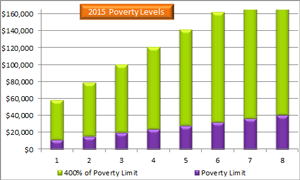H&W: 2015 Poverty Guidelines and Health Care Subsidies
 Health and Human Services has released their 2015 federal poverty guidelines. Through the Affordable Care Act (“ACA”), the 2015 poverty guidelines can be used in determining the affordability of health coverage and whether or not an individual may be eligible for public exchange subsidies for the 2016 plan year. For 2015, the federal poverty line (“FPL”) for an individual living in the 48 contiguous states is $11,770. This is an increase of $100 from 2014.
Health and Human Services has released their 2015 federal poverty guidelines. Through the Affordable Care Act (“ACA”), the 2015 poverty guidelines can be used in determining the affordability of health coverage and whether or not an individual may be eligible for public exchange subsidies for the 2016 plan year. For 2015, the federal poverty line (“FPL”) for an individual living in the 48 contiguous states is $11,770. This is an increase of $100 from 2014.
By now most of us are aware that due to ACA, if an applicable large employer has one or more full-time employees who receive payment of a premium tax credit when purchasing health coverage through the exchange/marketplace, a shared responsibility assessment could be levied against the employer. Code Sections 4980H(a) and 4980H(b) address when such an assessment might occur.
Section 4980H(a) penalties come into play when an employer fails to offer an opportunity to enroll in minimum essential coverage to its full-time employees (and their dependents) and one of those employees purchases coverage through an exchange and qualifies for a premium tax credit or subsidy. This is the “section (a)” penalty and it is levied annually (but calculated monthly) against the total number of full-time employees minus 30 (minus 80 for 2015).
Section 4980H(b) penalties come into play when an employer offers coverage to its full-time employees (and their dependents), but the coverage ends up not being affordable or does not provide minimum value. This is sometimes referred to as the “section (b)” penalty and it could be levied when an employee qualifies for the subsidy or tax credit. The penalty is determined monthly for each full-time employee that receives a tax credit.In reference to the section (b) penalty, there are 3 safe harbors that employers can use to help determine whether or not their plan(s) may put them at risk for a section (b) Penalty based on affordability:
- Form W-2 wages safe harbor
- Rate of pay safe harbor
- Federal poverty line safe harbor
Poverty Line Safe Harbor & Section 4980H(b) Penalty
Under the federal poverty line safe harbor, an applicable large employer’s offer of coverage to an employee is treated as affordable if the employee’s required contribution for the calendar month for the lowest cost self-only coverage that provides minimum value does not exceed 9.5 percent of a monthly amount determined as the federal poverty line for a single individual for the applicable calendar year, divided by 12. This safe harbor is intended to provide employers a predetermined maximum amount of employee contribution that in all cases will result in the coverage being deemed affordable. Running the math, an annual salary of $11,770 divided by 12 equals $980.83 per month which when multiplied by 9.5% results in a monthly contribution amount of $93.18. If a 2016 plan is such that an employee contribution for the calendar month for the lowest cost self-only coverage that provides minimum value does not exceed $93.18, it would be deemed affordable.
Federal Poverty Level & Non-eligibility for Tax Credits
What if your plan is not considered affordable under then FPL safe harbor or other applicable standard? Can the federal poverty line provide any insight that might be helpful in determining your exposure to pay or play penalties?
If you look at the eligibility criteria for a premium tax credit, one criteria is based on the FPL. In general, individuals whose household income for the year is between 100 percent and 400 percent of the federal poverty line for their family size may be eligible for the premium tax credit. If an individual’s household income level exceeds the 400% of the FPL or is less than 100% of the FPL, they would not qualify for a tax credit and therefore would not be in a position to trigger either a Section 4980H(b) penalty or a Section 4980H(a) penalty against your plan.
The table below, illustrates when the household income for 2015 would be between 100 percent and 400 percent of the federal poverty line for residents of one of the 48 contiguous states or Washington, D.C.
| Household Size | Poverty Limit | 400% |
| 1 | $11,770 | $47,080 |
| 2 | $15,930 | $63,720 |
| 3 | $20,090 | $80,360 |
| 4 | $24,250 | $97,000 |
| 5 | $28,410 | $113,640 |
| 6 | $32,570 | $130,280 |
| 7 | $36,730 | $146,920 |
| 8 | $40,890 | $163,560 |
| Note, an individual/family who meets these income requirements must meet all of the other eligibility criteria1 as well before qualifying for the credit. For additional information, click here | ||
Additional information: Internal Revenue Bulletin: 2014-9
1You may be eligible for the credit if you meet all of the following: buy health insurance through the Marketplace; are ineligible for coverage through an employer or government plan; are within certain income limits; do not file a Married Filing Separately tax return (unless you meet criteria which allows certain victims of domestic abuse and spousal abandonment to claim the premium tax credit using the Married Filing Separately filing status); and cannot be claimed as a dependent by another person. See IRS Premium Tax Credit for more information.